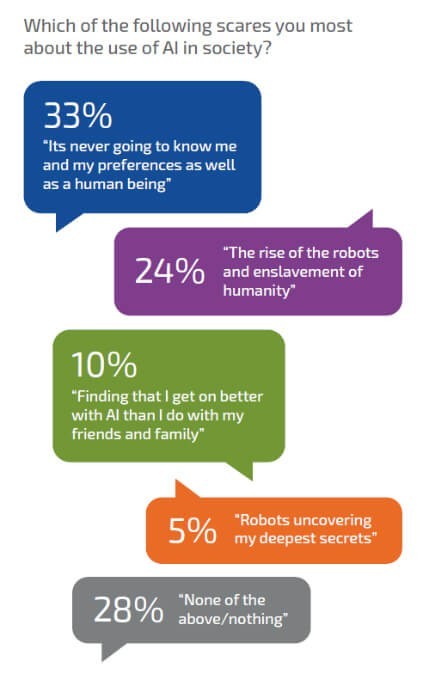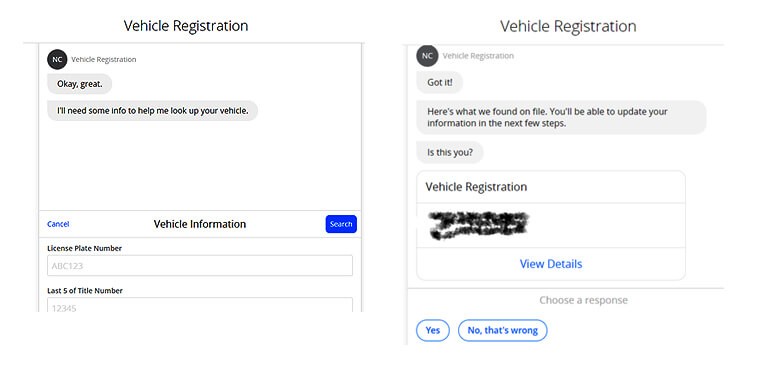Blog Chatbot for Business: A Chat About Chatbot Technology
In a conversation about acquisitions, a wise colleague once told me, “About a third of the people jump ship right away, mostly out of fear of the unknown. Another third will probably stay no matter what. The last third will take a bit of time, see what kind of place this is going to turn into, then evaluate their options.”
By J Broad / 18 May 2019 / Topics: Artificial Intelligence (AI) Customer experience

Although this quote is about morale at an acquisition target, I would argue that reactions to new technologies are the same, especially user-facing technology. A percentage of people will resist. Another group will embrace. But many will take a “wait and see” attitude. Chatbot technology is no exception.
What is a chatbot?
A chatbot is an artificial intelligence-enabled software application that can hold natural language conversations with users to assist their needs. Read the full definition here.
In a way, chatbots are victims of their own hype cycle. Phone and home assistants are a mixed bag of promises and compromises, but they’ve certainly done their part to bring the concept of chatbots — and, to a lesser extent, Artificial Intelligence (AI) — into the public consciousness.
To attempt to analyze customer sentiment regarding feelings and bias around chatbots can be an exercise in dichotomy. Users want a bot that can think and solve problems, understanding language specific to a particular application or industry.
However, according to a Pegasystems survey, about a quarter of respondents (24%) worry about “the rise of the robots” (see Figure 1). And a full 70% have a fear of AI in general.

Users want a chatbot with a friendly manner they can communicate with as easily as a human. Yet, a RichRelevance survey revealed 40.7% of respondents found chatbot answers to their questions more “creepy” than “cool,” according to a Chatbots Magazine article. People want to feel comfortable, but they don’t want to feel duped.
In the case of a support services bot, many folks already feel angst over the fact that they have to contact the provider for help. Tricking them into thinking a bot is a person doesn’t improve this dynamic.
Different types of chatbots
While chatbots can take many forms, they typically fall under two main categories — rule-based bots and bots that use Artificial Intelligence (AI).
Rule-based bots are created to provide scripted responses to specific inputs. For example, if you'd like to check the status of an online order, the bot can ask for your order number and it will provide an update. These are good examples when there is a clear question and answer combination.
Chatbots with AI build upon the rule-based bots, but use language processes capabilities to understand the intent behind a question and provide an appropriate reseponse.
Warming up to new technology
Back to my initial quote, my father was squarely in the “resistant” third for new technology. He used to close one eye when using the TV remote — most likely to avoid inadvertently vaporizing the lamp into another dimension if the beam wasn’t aimed at the TV properly. To be fair, my father had children late in life, and he found technology, in general, off-putting.
When ATMs first became a thing, my father refused to use them. He used to take 8-year-old me into the bank lobby to work “that machine” for him. His biggest fear seemed to be that it would “eat his card.”
ATMs used to completely consume your card and, if you made too many mistakes during your transaction (bad PIN, not enough money in the account, etc.), wouldn’t give it back. You’d have to go into the lobby during banking hours to ask for your card back.
As ATMs changed to allow your card to stay in your hand and provide more on-screen instructions, my father slowly became more comfortable with them. He still did the one-eyed thing with the remote, though.
How do we break this innate distrust of technology for a large swath of our chatbot consumers? It comes down to outcomes and objectives.
Embracing the benefits of chatbot technology
From a chatbot for business perspective, we’d like to shift some of the simpler, more redundant issues to a self-service interaction. The more cynical among you might see this as a “robots taking customer service jobs” play, but that doesn’t have to be (and probably shouldn’t be) the case.
If the ultimate goal is customer satisfaction as a way to increase profit, and not profit at the expense of the customer experience, then the time saved from this automatable task should be aimed at that objective.
More insight: Prioritizing customer needs is key to business success. In this article, discover five ways technology can enhance and personalize the customer experience.
More IT workers can be made available to focus on customer service and more complex tasks and tickets. This way, customers will find the resolution for routine needs comes quickly, without waiting in a queue for someone to walk them through resetting their passwords.
Consumers with more complex issues will find their wait times diminished with more employees available to help. This can also provide an opportunity to spend a bit more time on the relationship side with customers.
From the customer side, it’s all about their objectives when contacting the business in the first place. They want the quickest path to the solution for their particular issue. They want to feel that the provider of the service cares about their satisfaction and wants to help them through the shortest route to understanding their issue and resolving it. They want to feel their time isn’t wasted and that the messaging they get is consistent and positive.
A friendly chatbot experience
As a cautionary tale, think about early (and some current) Interactive Voice Response (IVR) systems. It was very difficult to be understood, and repeating the same phrase louder and slower didn’t always work. Without sentiment analysis, there was no way to measure a user’s frustration as he or she looped endlessly through a labyrinth of increasingly obscure options trying to find one that might match the category of his or her particular issue.
Those systems could waste vast amounts of the user’s time. In response, websites began to spring up that documented the most efficient ways through menuing systems — or the best way to get to a person with the fewest touch-tone entries. Customer satisfaction wasn’t high.
The same frustrations and pitfalls can be created with a poorly designed chatbot.
Design is everything: Your chatbot needs a purpose. In this blog, learn how to ensure it results in a great user experience.
On the other hand, I had a very positive chatbot experience recently while interacting with the Department of Motor Vehicles (DMV). (I know. I was surprised, too).
In the state where I live, you need to pay your yearly property taxes before you can renew your registration. This involves a little dance when you first buy a used car: getting a temporary plate, then a real plate with a temporary sticker, then a tax bill and, finally, a registration sticker good for a year.
Upon logging in to the DMV site and clicking the Pay My Taxes link, I was dropped into the chatbot interface. I admit I’m a tainted user, with a little more sensitivity to chatbot technology and capabilities than perhaps someone with less interest in the field would have, but I had an unexpectedly painless experience. The chatbot greeted me and immediately set about gathering the information needed to fulfill my request.
The personality of the bot was muted but cordial (not over-the-top friendly but colloquial enough to feel like a real conversation). The interface provided a mix of text and clickable links to guide me down the right path.
When the bot asked for information, it always confirmed that information before proceeding to the next step (see Figure 2). I was able to look up my tax bill by license plate, confirm my identity, pay my taxes by debit card and get the receipt sent to my email in about three minutes.

Phone calls to the DMV are interminable in my area. The workers are pleasant to talk to and very helpful, but the wait can seem longer than an airport security line when you’re late for a flight.
I haven’t been inside a DMV office since I moved to this area three years ago, and I don’t plan to be. But this chatbot … we could be friends.
Needed: An adaptive approach
By focusing on the business outcomes we’re targeting and aligning them with the objectives of our clients, we can deliver a great chatbot experience. Keeping in mind the disparate groups and the different ways people approach new technologies (remember our breakdown of resist, embrace and evaluate), the approach will need to be adaptive and iterative.
As users, we want our chatbots to be smart but not smart enough to take over the world. We want to have a good experience paying our taxes at the DMV while making sure that lamp doesn’t explode. And we want our chatbots to be humanlike — but we don’t want to be fooled into thinking they’re human.




